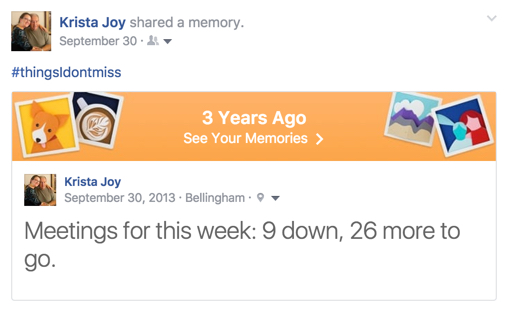-
Effective meetings & effective note-taking

This is the last post in my series on organization. Meetings may not be something that you immediately tie to being organized, but I’m including it because meetings can be either a huge time suck or a useful tool in creating organization among a group of people. And I can’t talk about meetings without talking […]
-
Getting stuff done: how to organize tasks and stay focused

This is the second post in my series on getting organized. Today we’re focusing on how to prioritize tasks and stay focused until they’re finished. #1 Use a system that reminds you I’m a huge fan of Getting Things Done (GTD). To get a feel for the concept behind GTD, ask yourself, “Does my brain consistently remind […]
-
Overcoming roadblocks
I’m an independent, let me “do it myself” and “I’ll make it happen” kind of person. I tend to intuitively “get” what needs to get done and identify the most efficient way to get there. So when I hit an impediment that I can’t get around I get stuck. Really stuck. Like when there’s a scratch on a […]
-
Two steps to making decisions on projects
In project management decision-making is inevitable. In fact, I have come to think that project management is primarily about making sure the necessary decisions get made at the right point in time. Recent my co-worker Nathan R Elson, wrote a blog about the decision parallax. (I’ll be the first to admit I had to look […]
-
The one thing that never fails… emergencies
In Army basic training, drill sergeants launch CS gas (AKA tear gas, pepper spray) grenades into formations of recruits. There is a set procedure: close your eyes hold your breath pull down your glasses (if applicable). If you’re wondering: they stay around your neck because of the geek strap! open gas mask pocket pull it […]
-
Project Management and Rapid Redirection
Four weeks ago a major project came through the marketing department like a tsunami. The rapid transition from projects that already were underway to something of this magnitude caused me to think about managing projects and tasks in a way that allows for quick redirection. I strongly believe that as a project owner/manager, it’s important […]
-
Using Excel for Project Planning
I’ve used Microsoft Project in the past. There were some features I really liked, but mostly I found it frustrating, cumbersome and time-consuming. I hate wasting time; I have an obsession with being as efficient as possible. So a few years ago I ditched Project and decided to use Excel to handle my project management […]
-
Using Excel for Resource Planning
Right now I’m planning every promotion we’ll be doing in 2013. This represents hundreds of different promotions that will be managed by more than a dozen people. I’ve been using Excel to build my list of promotions so that I could: Easily filter them by categories (huge vs mini promotion, sale vs product promotion, etc.) […]